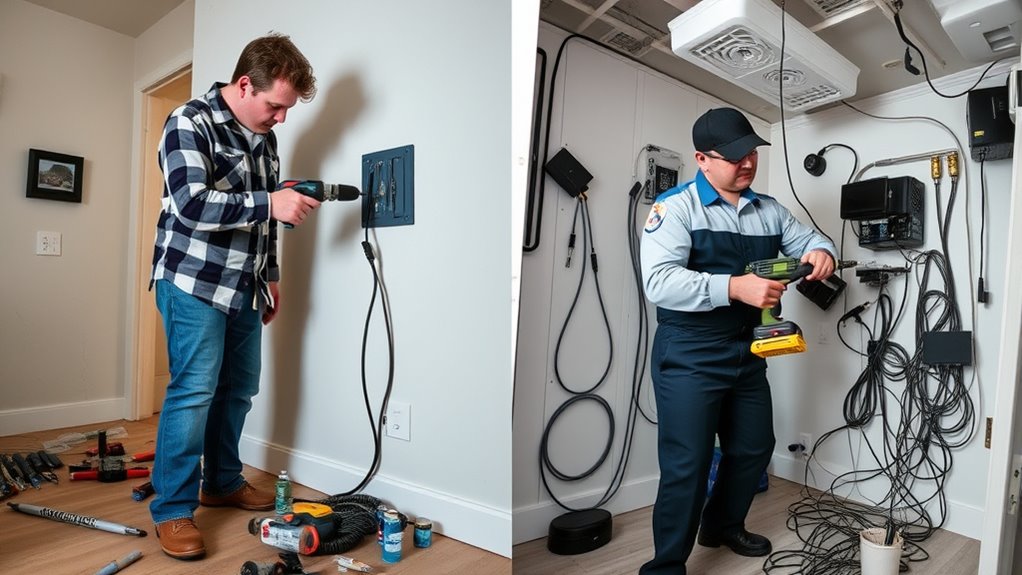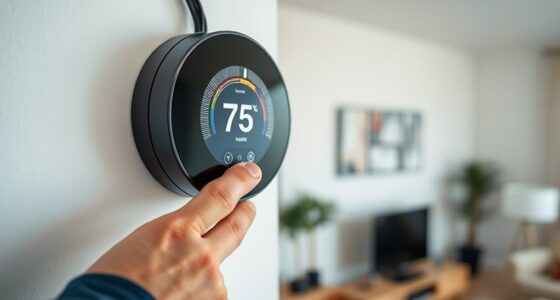Choosing between DIY and professional installation affects your costs, safety, and quality. DIY can save money upfront but might lead to errors, damage, or safety hazards that cost more long-term. Professionals usually charge more but guarantee proper, durable, and safe work, reducing risks and future repairs. Considering skills, time, and hidden costs, your best choice depends on balancing budget and peace of mind. Keep exploring to discover how to make the smartest decision for your project.
Key Takeaways
- DIY projects often have higher upfront tool costs and hidden risks, potentially outweighing savings.
- Professional installation typically ensures faster completion, higher quality, and long-term durability.
- Inexperienced DIYers risk damage, safety hazards, and increased repair costs over time.
- Professionals provide compliance with safety standards and legal requirements, reducing liability.
- Overall value depends on balancing initial costs, quality outcomes, and peace of mind.
Upfront Expenses and Material Costs
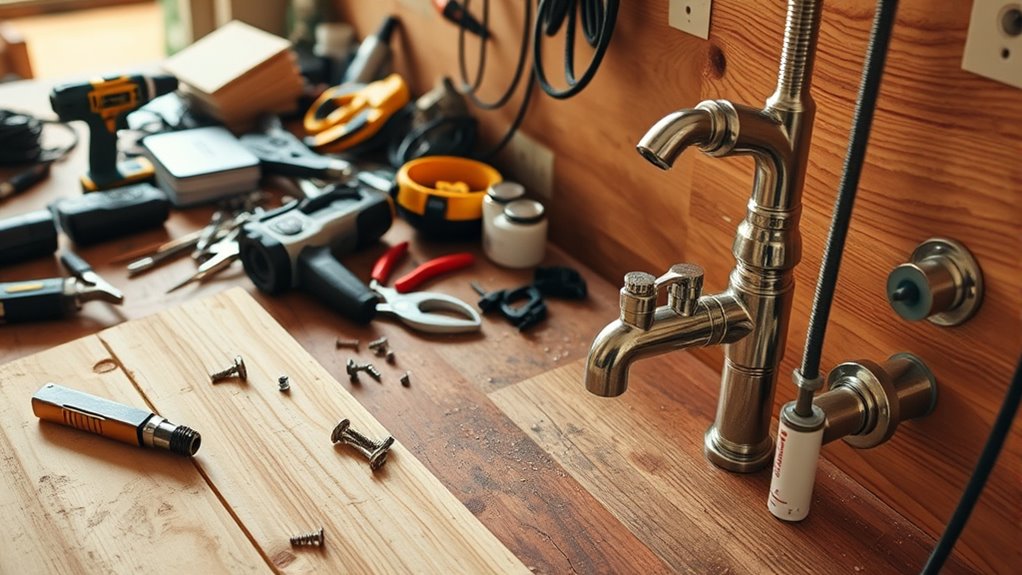
When considering whether to tackle a project yourself or hire a professional, upfront expenses and material costs play a crucial role. Your choice impacts the initial investment, especially in tool selection, which can be costly if you need specialized equipment. DIY projects often require purchasing or renting tools, increasing your upfront expenses, but you gain design flexibility, allowing you to customize every detail. Professionals, on the other hand, usually bring their own tools, reducing your initial costs. However, their expertise can lead to higher labor fees, which might balance out the savings on tools. Keep in mind that careful planning of material costs and tools can help you stay within budget, whether you decide to DIY or hire a pro. Additionally, understanding cost management techniques can provide insights into efficient project planning and cost management. Considering the potential need for specialized equipment, it’s wise to evaluate whether the investment aligns with your project’s scope and your budget constraints.
Labor and Time Investment
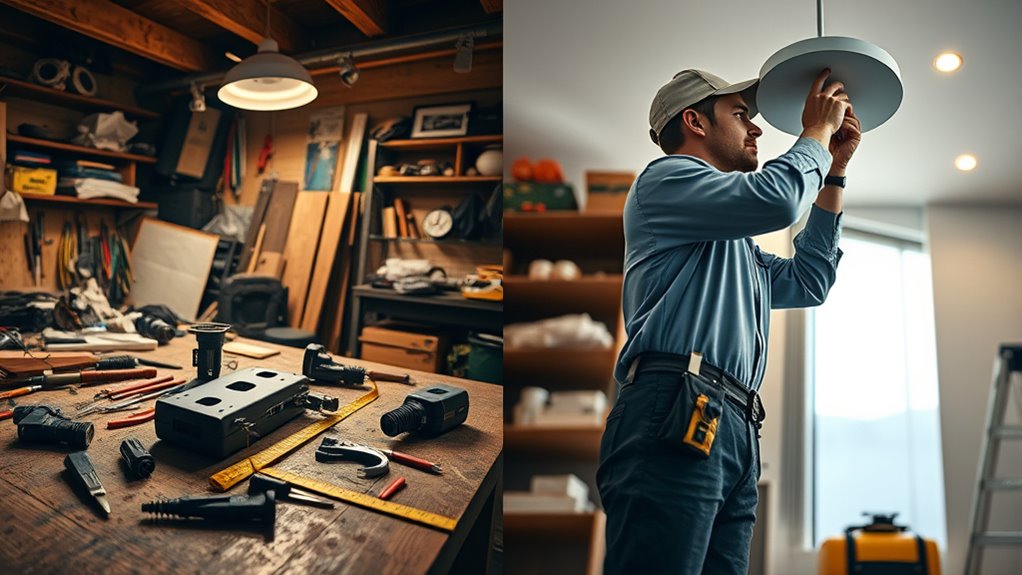
You’ll need to contemplate how much time you’re willing to invest, as DIY projects often take longer than expected. Assess whether your skill level matches the task, since mistakes can lead to extra work or costs. Don’t forget to factor in hidden labor costs, like additional tools or repairs that might come up along the way. Moreover, consider the cost of tools and supplies, which can sometimes outweigh the expense of hiring a professional. Additionally, underestimating the complexity of certain tasks can result in unnecessary setbacks, prolonging your project and increasing costs. When working on Hyundai Tuning, understanding the intricacies of engine and suspension modifications is crucial to avoid costly errors.
Time Commitment Required
Choosing between DIY and professional installation considerably affects how much time and effort you’ll need to invest. For DIY projects, you’ll need to consider the tools needed and how they match the project scope. Smaller, straightforward tasks might take a few hours, while larger projects could require days. You’ll spend time gathering tools, preparing the space, and executing each step carefully. proper planning can help streamline the process and reduce unnecessary delays. On the other hand, hiring professionals often means they handle the entire process efficiently, saving you time. They bring the right tools and experience, which accelerates completion. Your role may be limited to coordinating or waiting for the job to finish. Ultimately, your time commitment depends on the project’s complexity and your availability, but in general, DIY demands more of your time and effort upfront. Additionally, knowing how familiarity with tools impacts the timeline can help you better prepare and set realistic expectations. When working with modern toilets, understanding flushing mechanisms and their efficiency can also influence how quickly the installation process goes, especially if adjustments are needed.
Skill Level Needed
The skill level required for installation directly impacts the time and effort involved, whether you’re tackling the project yourself or hiring professionals. If you’re doing it yourself, you need tool familiarity to work efficiently and safely. Strong problem solving skills help you troubleshoot unexpected issues that arise during installation. Without experience, tasks like wiring or mounting can become complex. Additionally, understanding projector calibration techniques ensures optimal image quality after setup. Consider these factors:
- Knowing how to operate specific tools confidently
- Ability to interpret instructions or diagrams
- Troubleshooting issues without professional guidance
- Patience to handle unforeseen challenges
- Understanding Honda Tuning modifications and their implications
- Awareness of hamster care costs and proper maintenance routines to ensure longevity and avoid unnecessary expenses
If your skill level isn’t high, you might spend more time learning or correcting mistakes. Professionals bring experience that minimizes errors and accelerates the process, saving you time and reducing frustration.
Hidden Labor Costs
Hidden labor costs can catch you off guard, especially when estimating the true investment of a DIY project. You might think you’ll save time, but unexpected delays and tool compatibility issues can stretch out your effort. If your tools aren’t compatible or don’t work as expected, you’ll spend extra hours troubleshooting or purchasing new equipment. Additionally, achieving the desired aesthetic appeal takes more than just installing; it requires patience and precision, which can extend your project timeline. These hidden costs in labor and time can quickly outweigh savings, especially when you factor in multiple attempts to get everything right. Recognizing these potential pitfalls helps you better understand the real cost of DIY versus professional installation, where experienced pros often handle these challenges efficiently. Moreover, consulting with architectural solutions professionals can help streamline your project and avoid costly mistakes. Being aware of well-being tips such as stress management techniques can also help maintain your patience during complex projects.
Skill Level and Expertise Requirements
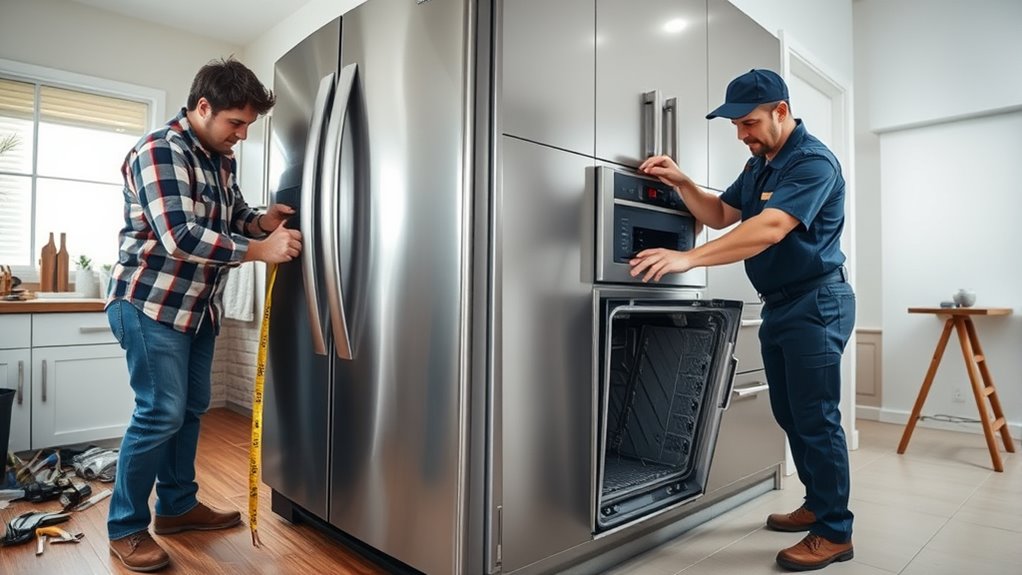
While DIY installations can seem straightforward, they often require a certain level of skill and technical knowledge that not everyone possesses. You’ll need to understand tool compatibility to guarantee your equipment works correctly and safely. Having the right skills also impacts your ability to customize for design flexibility, creating a look that matches your vision. Without proper expertise, you might struggle with complex steps or troubleshooting issues. Additionally, understanding testing methodologies can help you verify that your installation meets quality and safety standards. For example, knowing how to evaluate motor performance and battery integration can prevent potential failures. Consider the following:
- Operating specialized tools safely and effectively
- Understanding electrical or plumbing connections
- Adjusting designs to fit your space and style
- Troubleshooting installation problems as they arise
- Recognizing technical requirements that ensure a safe and compliant setup
If your skill level isn’t high, attempting DIY could lead to subpar results or damage that costs more to fix later.
Risk of Errors and Damage
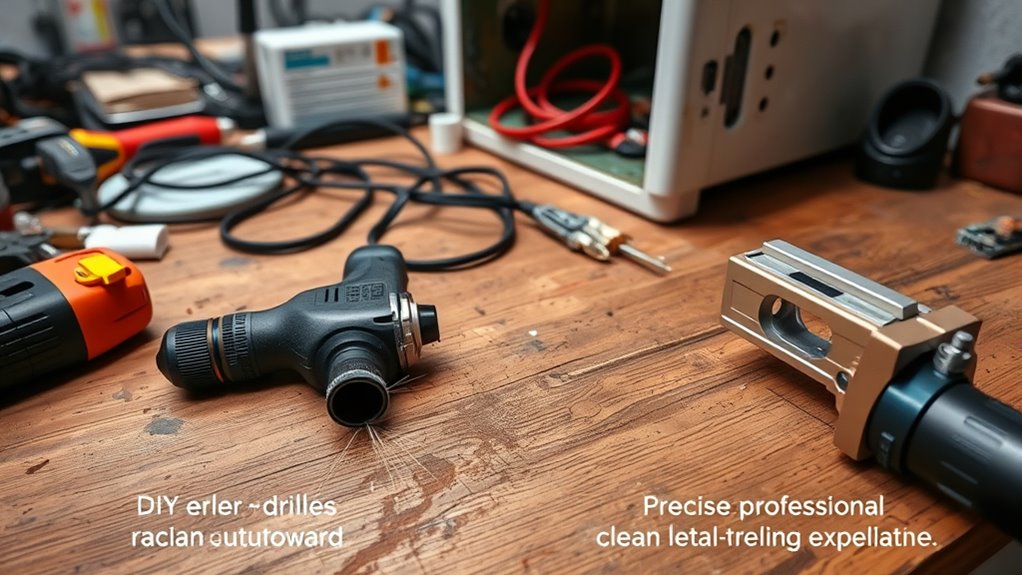
Attempting a DIY installation increases the risk of errors that can lead to costly damage or safety hazards. If you’re not familiar with proper procedures, you might struggle with tool compatibility, causing installation mistakes or damage to your property. Incorrect handling can result in broken parts, leaks, or electrical issues that are difficult and expensive to fix later. Additionally, poor installation can compromise the aesthetic appeal of your project, leaving it looking uneven or unprofessional. These errors aren’t just visual; they can affect safety and functionality, increasing the chances of accidents or system failures. Without proper expertise, you might overlook small details that make a big difference, ultimately risking more damage and higher costs down the line. Proper installation techniques are crucial to ensure your project complies and avoids legal issues. Understanding local laws and regulations can also be crucial to ensure your project complies and avoids legal issues. Furthermore, proper installation methods are essential to ensure filtration efficiency and overall system performance, especially for specialized equipment like HEPA filter vacuums.
Long-Term Durability and Performance

Proper installation plays a significant role in guaranteeing your project’s long-term durability and performance. When you choose professional installation, you benefit from expert knowledge of material quality and design flexibility, which directly impacts how well your project holds up over time. High-quality materials are installed correctly, reducing the risk of premature wear and failure. Skilled professionals can adapt designs to fit your space perfectly, maximizing longevity and functionality. An understanding of self-watering plant pot mechanics can further ensure the system operates efficiently over time. DIY projects may save money initially but often lack the precision needed for lasting results. Over time, this can lead to issues that compromise durability. Investing in professional installation ensures your project is built to last, with ideal material use and design execution that supports long-term performance.
Potential for Additional Repairs or Replacements
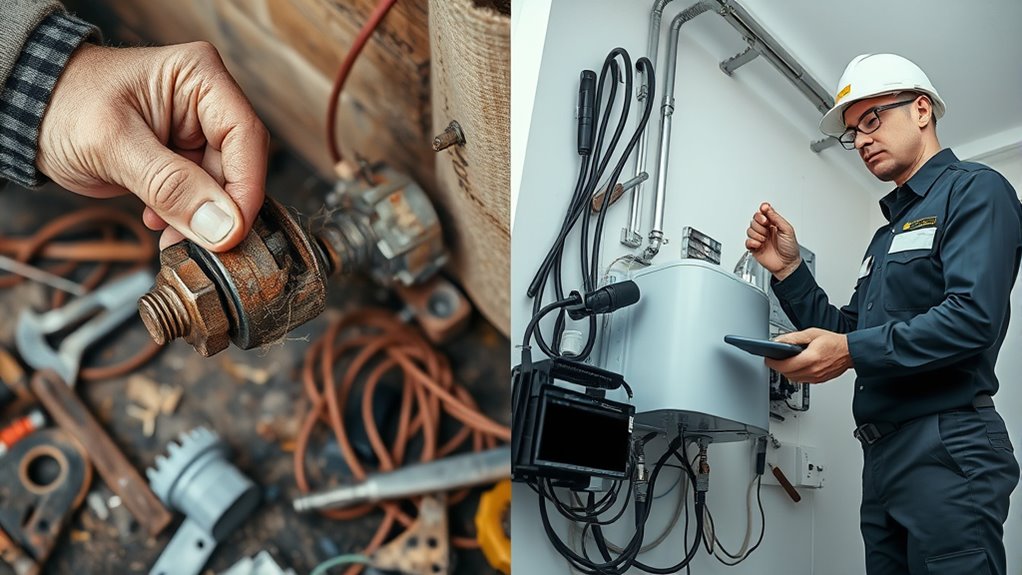
Choosing DIY installation can increase the likelihood of needing repairs or replacements later on. Without proper experience, you might accidentally damage parts or install them incorrectly, leading to costly fixes down the line. Warranty issues are another concern—many warranties become nullified if the product isn’t installed by a professional, leaving you responsible for repairs. Additionally, tool accessibility can be a hurdle; professional installers have specialized tools that ensure proper setup, reducing the risk of damage. When you DIY, you might lack the right tools or knowledge to handle unexpected problems, increasing the chances of needing future repairs. Over time, these issues can add up, making DIY installation more expensive and time-consuming than initially anticipated. Knowing about proper installation techniques can also help you choose the right tools and methods tailored to specific installation needs. Relying on professional expertise can mitigate many of these risks and ensure a more durable, reliable setup.
Safety Considerations and Liability
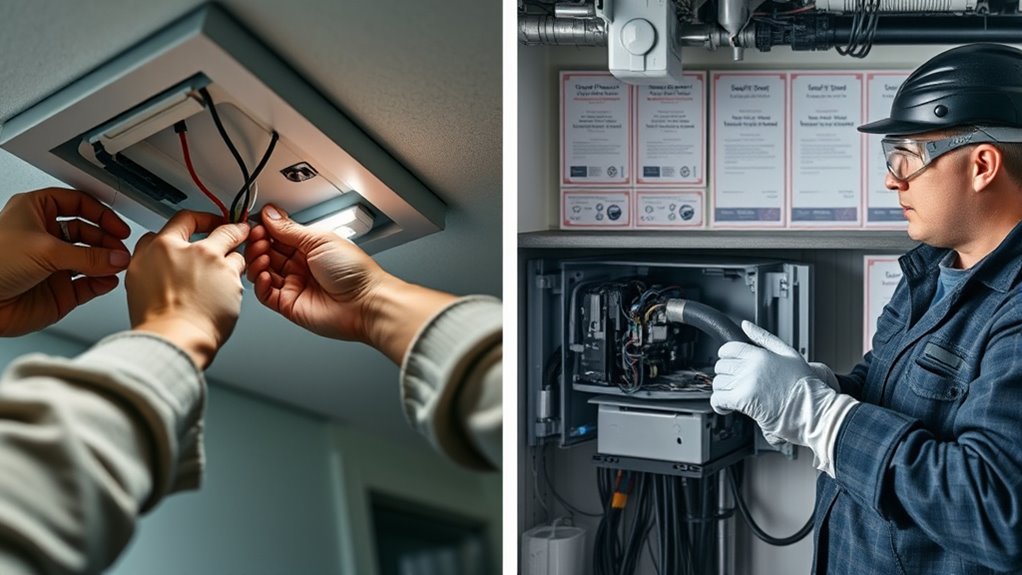
When you install a product yourself, safety risks can increase considerably if you lack the proper knowledge and equipment. Improper installation can lead to accidents, injuries, or property damage, which may affect liability and insurance claims. Failing to follow safety standards or regulatory compliance can result in fines or voided insurance coverage. You might also face legal issues if an injury occurs due to negligence. To reduce risks, ensure you understand safety guidelines, use appropriate tools, and verify your work complies with local codes. Consulting professional services may be necessary for complex installations or when local road sign regulations vary, ensuring adherence to safety and legal standards.
Overall Value and Satisfaction

While safety considerations are essential, evaluating the overall value and satisfaction of your installation also depends on how well the job meets your expectations and needs. Your cost comparison plays a big role here—consider whether DIY saves money or if professional installation offers better quality for the price. Satisfaction factors include the reliability, durability, and appearance of the finished work. If you handle the job yourself, you might enjoy a sense of accomplishment, but it could also lead to frustrations if issues arise. Conversely, professionals often guarantee their work, boosting your confidence in the outcome. Ultimately, the true value hinges on your priorities: saving money, ensuring quality, or achieving peace of mind. Weigh these factors carefully to determine what offers the best overall satisfaction for you.
Frequently Asked Questions
How Do Installation Costs Vary by Project Size and Complexity?
Installation costs change based on project scale and material complexity. For small, straightforward projects, costs stay lower because less labor and simpler materials are involved. As project size increases, or if materials are complex or specialized, expect higher costs due to extra labor, tools, and skills needed. You should consider these factors when planning your project, as they directly impact your total expenses and the effort required to complete it.
What Hidden Costs Might Arise During DIY or Professional Installation?
When considering installation, you might encounter hidden costs like needing to upgrade material quality if initial choices don’t hold up, or facing unexpected labor expenses if the project takes longer than anticipated. Whether you’re doing it yourself or hiring pros, these hidden costs can sneak in, so it’s wise to budget extra for potential material issues and unforeseen labor needs to avoid surprises later.
How Does Warranty Coverage Differ Between DIY and Professional Work?
Did you know that professional installations often come with superior warranty coverage? Warranty differences mean you might get longer or more extensive protection with a pro, reducing future costs. Coverage implications are significant—DIY work can void warranties or limit repairs, leaving you unprotected. So, when considering installation options, think about how warranty coverage impacts your long-term costs and peace of mind. It’s a key factor in making the right choice.
Can DIY Installation Affect Insurance Claims or Coverage?
You should know that DIY installation can impact your insurance coverage and claims. If insurance providers discover your work isn’t up to code or causes damage, they may deny coverage or face coverage disputes. This can leave you financially responsible for repairs. Always check your policy and consider professional installation to verify your insurance stays valid and your coverage remains intact, avoiding potential issues during claims.
What Factors Influence the Long-Term Maintenance Costs of the Installation?
You should consider how material durability and labor quality influence long-term maintenance costs. Durable materials reduce the need for frequent repairs, saving you money over time. Skilled labor ensures proper installation, preventing issues that could escalate maintenance expenses. Poor workmanship or low-quality materials might lower initial costs but can lead to higher upkeep, repairs, or replacements later on. Investing in quality from the start helps keep maintenance manageable and affordable.
Conclusion
Remember, you get what you pay for. While DIY might save money upfront, it can lead to costly mistakes or safety risks down the line. Weigh the time, skill, and potential errors against professional expertise to make the best choice. Sometimes, it’s worth investing a little more now to avoid paying much more later. Don’t let “penny wise, pound foolish” be your guiding rule—choose wisely for lasting peace of mind.
